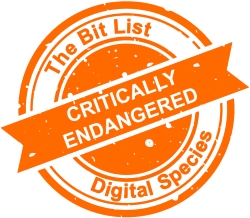Records of Quasi Non-Governmental Agencies
 |
||
|
Records from agencies at arms-length to government whether locally, nationally or internationally. They may be required to maintain archives for the purposes of transparency, sometimes for extended periods, and sometimes in diverse and complicated forms. |
||
|
Digital Species: Public Records |
Trend in 2023:
|
Consensus Decision |
|
Added to List: 2019 |
Trend in 2024:
|
Previously: Critically Endangered |
|
Imminence of Action Action is recommended within twelve months, detailed assessment is a priority. |
Significance of Loss The loss of tools, data or services within this group would impact on people and sectors around the world. |
Effort to Preserve | Inevitability It would require a major effort to prevent or reduce losses in this group, possibly requiring the development of new preservation tools or techniques. |
|
Examples Records of non-executive state or national agencies; museum or leisure trusts; industry or public regulators; public audit services; public-good funding and investment agencies; autonomous and semi-autonomous public agencies; sovereign wealth funds; public/private partnerships; publicly owned companies. |
||
|
‘Practically Extinct’ in the Presence of Aggravating Conditions Lack of preservation infrastructure; conflation of backup with preservation; loss of authenticity or integrity; Long-lived business processes; poor storage; churn of staff; significant volumes or diversity of data; poorly developed digitization specifications; ill-informed records management; poorly developed migration or normalizations specifications; long-standing protocols or procedures that apply unsuitable paper processes to digital materials; encryption; political instability; lack of sustained funding; Uncertainty over IPR or the presence of orphaned works. |
||
|
‘Endangered’ in the Presence of Good Practice Well-managed data infrastructure; preservation enabled at the point of creation; carefully managed authenticity; use of persistent identifiers; finding aids; well-managed records management processes; application of records management standards; recognition of preservation requirements at highest levels; strategic investment in digital preservation; preservation roadmap; participation in digital preservation community. |
||
|
2023 Review This entry was added in 2019 as a subset of a previous entry for ‘Records of long duration from Local Government or Other Government Agencies.’ The split was intended to allow greater concentration on the challenges that these different types of agencies face. Records of quasi non-governmental agencies are at arm’s length to government, but the ’QuaNGO’ or ‘ALEO’ (Arms-Length Executive Organization) may lack the capacity to meet complex digital preservation requirements that arise, nor be able to deposit in the government archive. The 2021 Jury added that arm's length bodies are still public bodies, and they have a duty of care for maintaining evidence of their actions and transactions. They often receive public funding, and depending on the archives, legislation may be required to transfer to an archive. The issue is when there is a lack of clarity regarding the recordkeeping requirements or neglect of records and information once it has outlived its usefulness. These bodies still create records that affect citizen lives and have a duty to document, and therefore changed the classification from Endangered to Critically Endangered. The 2021 Jury and 2022 Taskforce noted a trend towards greater risk when looking at the precarity of records in QuaNGO agencies in periods of significant political and economic upheaval creating greater strains for funding to support preservation capacity. The 2023 Council generally agreed with the Critically Endangered classification with the overall risks remaining on the same basis as before (‘No change’ to trend). The 2023 Council additionally recommended revisiting and rescoping this entry as part of the next major revision of the Bit List. Some recommended splitting this entry into separate entries to differentiate the various risks associated with different types of digital records of quasi non-governmental agencies. Others suggested that it is perhaps not appropriate to have a distinct entry or split entries but rather provide examples of different kinds of these digital materials in and across other entries. |
||
|
2024 Interim Review These risks remain on the same basis as before, with no significant trend towards even greater or reduced risk (‘No change’ to trend). |
||
|
Additional Comments There is a large variation in the types of records held by QuaNGOs and/or ALEOs. Additionally the quality of digital preservation performed can vary widely. Therefore, the same approach to scoring was taken for this entry as the one above. Similar to the risks of NGOs, we consider these records to be at greater risk due to there being less regulation, and the regulations that exist being less stringently enforced. An additional risk factor for these records is a blurring of the lines of responsibility, which can lead to records 'falling through gaps', or to difficulties funding digital preservation practice. This can be further complicated by outdated legislation which does not take into account the complexity of privatisation and public/private partnerships. Although the split draws attention to the different pressures faced by QuaNGOs it could be further subdivided into legally required public records and additional information that may enrich our digital preservation of society. The classification assumes that the roles and requirements for records management are clearly defined, but if this is not the case or there are inadequate resources to match the requirements, then the risk goes up. While the 2022 trend shows increases in risk there are some green shoots of hope in Ireland found when working actively with the agencies, and communicating some of the concerns they have for their data so there's better awareness and hopefully that will turn into action. See also:
|
||









































































































































